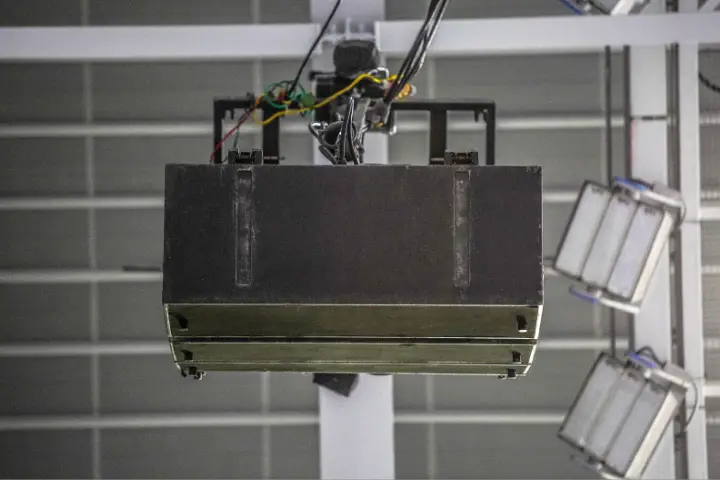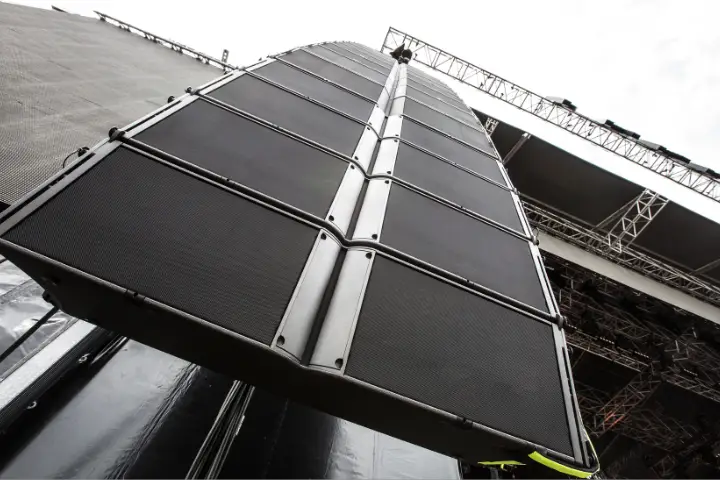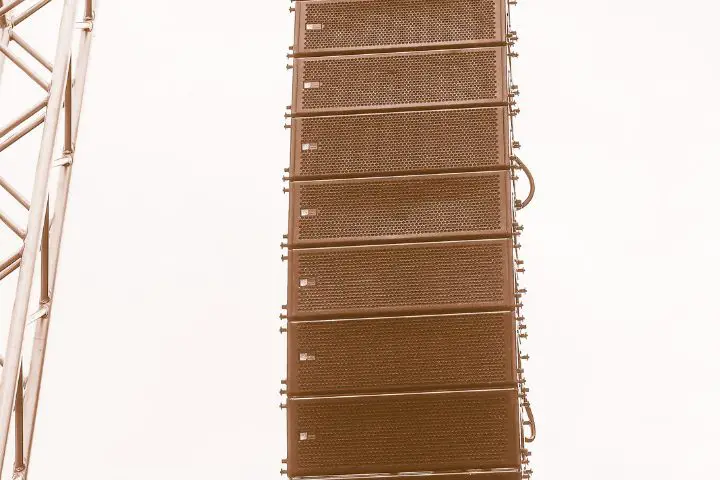In this article, we will discuss line array speakers and answer: How to build line array speakers.
Table of Contents
Line arrays are speaker systems that constitute multiple speaker units with the same characteristics arranged vertically such that they emulate a linear acoustical source. While line arrays have been in use since the mid-eighties, vertical line arrays have gained immense popularity in the past few decades.

They can be spotted at huge concerts, generally in a long J-shaped series of speakers suspended on either side of the stage. This article will answer questions surrounding line array speakers and look at some tips that will come in handy for building line array speakers.
What are the advantages of vertical line array speakers?
Vertical Pattern Control
The length of the line array determines the vertical coverage of the low frequencies emitted from it. The taller the former, the better the latter. The roof and floor surfaces are where a significant amount of reflection occurs. Since it reduces the sound sent towards the ceiling, unwanted reflections towards the listeners get minimized.

Sound reinforcement with more consistent sound pressure
When it comes to line array speakers, the sound pressure is affected less by distance. Owing to this, there is clear and consistent sound reinforcement. Not only this, but tall arrays can also reduce the amount of sound that leaks onto the stage. Sound pressure is affected by distance, resulting in excessive in-front-of-stage volume.
Less prone to feedback
Hence, a microphone close to the line array picks up small energy from the closest units. As a result, the net incoming energy is considerably smaller than the standard speakers, making feedback less likely.
You might also like to read : Are Speakers Covered Under Car Warranty?
What are the disadvantages of vertical line array speakers?
While we have looked at the advantages, let us now look at the disadvantages of vertical line array speakers.
Cost
Arrays are not inexpensive at all. On the contrary, they cost a hefty amount, which is understandable owing to the number of speakers involved.
Size
Array speakers consume a lot of space, and transporting them, storing them is difficult owing to their size. They can also be dangerous when surrounded by pets, kids, and some really fun party animals.
You might also like to read : How To Ship Floor Standing Speakers: 3 Steps You Must Follow
Is it still a line array if it is curved?
Good question, eh! The curved one is a curvy-linear array, which is often termed a ‘J-array.’ The same functions akin to line array speakers. However, the term line array is commonly used interchangeably with curvy linear array speakers too. Spiral arrays are a fairly new development from J arrays.
Why do line array speakers sound different?
Modern line array speakers employ separate drivers for low, mid, and high-frequency passbands. In addition, the lower portion of the line array is curved backward. This backward curve increases dispersion at the bottom of the array and allows sound to reach the audience.

How do line array speakers work?
Well, there is some insane Physics involved, and we are certainly not getting in there. The pure line array theory is based on geometry. Simply put, a line array speaker works like a line source. Line sources propagate sound equally in all directions.
This sound propagates in the form of a cylinder and not a sphere. Doubling the radii of the cylinder results in doubling of the surface area of the cylinder hence formed. However, there is a limit to the distance whereby a line source of finite length produces a sound pressure higher than an equally loud point source.
The length of the arrays determines which wavelengths will be affected by this narrowing of dispersion. However, one must keep in mind that line array systems act as line sources only in the low and mid frequencies. In frequencies other than the aforementioned, software such as EaseFocus are employed to study their behavior and usage.

Line arrays can be oriented in any direction, but they are primarily used in a public address in vertical arrays. One can spot vertical array speakers in huge concert halls, concert environments, and churches. They are designed by calculating the sound pressure level and room/ area dimensions using certain software.
The program hence provides the most suitable number and arrangement of speakers in the given environment. This information is made available to the consumer through physical spreadsheets demonstrating the layout and installation instructions in a physical booklet to the consumer inside the packaging.
Are line array speakers better?
Yes, column speakers and vertical line arrays provide good vertical coverage control and are better in some areas than other speakers.
Can you build your speakers?
Yes, you can build your speakers. It is one of the most rewarding and cost-efficient DIYs to exist. Speaker kits for the same are priced as low as $100, and adding components of your choice to the same can increase the cost to $1000. Finding the ideal kit and having the time to execute it are the most important things in building your speakers.
Is it easy to build a speaker?
Well, building a speaker is not so easy and not so difficult. There is a lot that needs to be taken care of. You can begin by gathering and reading some technical details about speakers from the internet.

Building Line Array Speakers
Here are some tips and tricks that will come in handy if you choose to DIY array speakers on a good weekend when you have finally gathered the will to do so.
CNC Router for the holes
Using a CNC router for drilling holes, especially big ones in the front pane, can easily be done with a CNC router. You can make a simple CAD drawing and walk to the nearest store where one can do this. Getting this done will smoothen the process manifold.
Shun Wire Wound Resistors
Try to avoid purchasing wire wound resistors as there is some inductance associated with them. And, this inductance by default is not taken into consideration while designing.

Wiring the crossover
Take a print of the crossover layout and stick it to the inside of it so that if you ever need to disassemble and fix something, you have at hand the layout for ease of reassembly.
Spacing
If you already have the drivers, you would want to simply put them into a line array. While doing so, ensure you adequately space the drivers such that the space between the woofer and tweeter array is at a minimum.
Avoid mix and match.
Do not mix speaker boxes from different manufacturers.
Consider investing in a DIY kit.
If gathering all the tools and equipment seems to be an arduous task to you, consider investing in a DIY kit. The kit comes with a detailed list where manufacturers typically illustrate the assembly of speakers. Read through the same thoroughly before beginning with the process and follow the steps as-is for execution.
You might also like to read : Buzzing From Speakers When Playing Games And 9 Things You Can Do About It
Did we cover everything?
Is there anything you feel we missed? Are there any speaker-related experiences you would want to share with us? Do not think twice; write them in the comments down below. We would love to read them. Also, do not forget to share the same with friends and family who find this information useful. Thanks for stopping by.